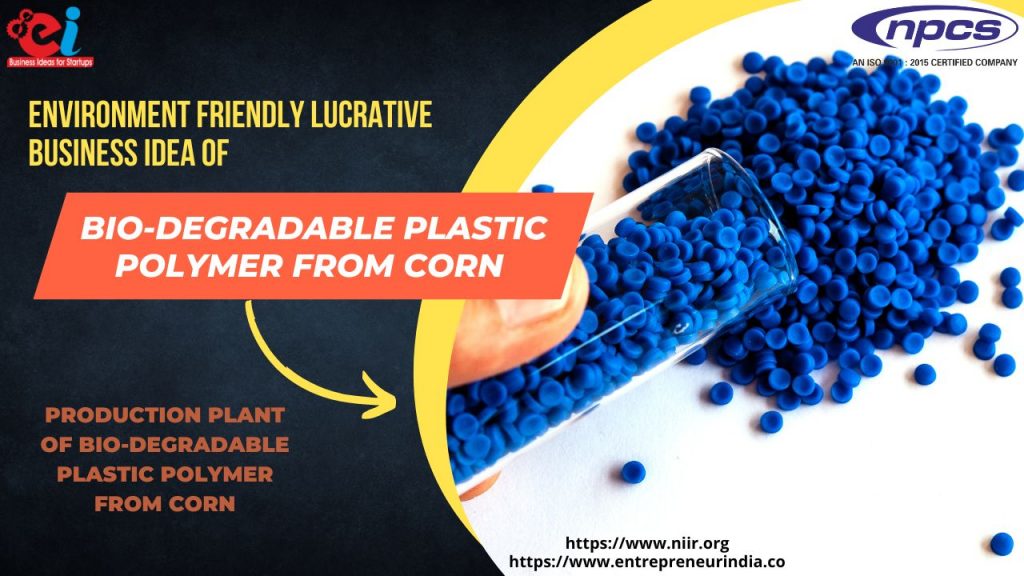Traditional plastics, which are comprised of petroleum and can take hundreds of years to degrade, can be replaced by biodegradable polymers. You may create biodegradable plastic that is 100 percent natural and decomposes in a matter of months by using the maize plant. It’s a win-win situation because this new kind of plastic is not only more environmentally friendly but also less expensive than conventional plastics. Although it doesn’t cost much extra to create this new biodegradable plastic, once retailers start purchasing it and switching out their outdated packaging with it, hopefully something will change within the next two years! Additionally, this material has no impact on the environment because it is 100% natural. You no longer need to be concerned about your carbon footprint because there is a great option to go green right now without causing any damage to the environment.
Visit this Page for More Information: Start a Business in Biodegradable Products Industry
Uses and Applications:
It is innovative to use corn to make biodegradable plastic, which can subsequently be used to manufacture packaging and other products. This kind of polymer is produced without the use of fossil fuels or the release of greenhouse gases because it is made from renewable resources. Additionally, it is biodegradable, which means that after a year, it will disintegrate without leaving any poisonous trace.
The business has so far created samples of its material that can be used for things like water bottles and supermarket bags in everyday life. The potential impact of plant-based bio plastic on our society is enormous. Consider all the single-use plastic bags you would avoid using to bring your groceries home as a benefit to both society and the environment! You might be interested to know that, while each plastic has distinct qualities and uses less energy during production, this material isn’t intended to replace plastics like polypropylene (PP) or polyethylene terephthalate (PET), but rather to function in conjunction with them.
Related Business Plan: Bio-Degradable Plastic Polymer from Corn
Manufacturing Process:
Corn must first be produced as a raw material. Add catalyst and make the degradable polymers as homogenous as possible. Second, put it under high pressure before putting it into the reactor. PMR, a biodegradable plastic, is the starting point. Third, add a binder, a color, and other additives to polymers to create finished products like biodegradable films, bags, and bottles. Fourth, put it in a saleable package.
Read Similar Articles: BIODEGRADABLE PRODUCTS
Benefits of Starting Bio-Degradable Plastic Polymer from Corn Production Business:
->More affordable than polythene. Both disposable and biodegradable –> a resource that is renewable and lessens our reliance on fossil fuels (especially oil). Our society, economy, and environment will all benefit significantly from the energy we conserve. Reduces landfilling, which is viewed as a major environmental issue worldwide. –> More environmentally beneficial than any other materials. –> By delivering slow-releasing nitrogen, which enhances soil quality, helps increase soil fertility. High compressive strength can be used to create toys, containers, utensils, and more.
Market Size in India:
Some of the factors driving the India bio-plastics market include rising consumer eco-awareness, mandates and regulations, corporate sustainability initiatives, technology stabilization, and cost-cutting.
Non-biodegradable polymers like PET and PE made from bio-based materials are the primary causes of this proliferation (polyethylene terephthalate). Biodegradable polymers such as polyhydroxyalkanoates, polylactic acid, and polylactide (PLA) are gradually increasing in production income. More polyethylene and polyethylene terephthalate are being used in the packaging sector, which is driving up demand for non-biodegradable plastic. The absence of alternative products and lack of knowledge are limiting market expansion.
Related Feasibility Study Reports: How to Make a Successful Business Out Of Bio-degradable Plastic Polymer From Corn
Global Market Outlook:
“Biodegradable plastics” are plastics that entirely break down in the environment. Microorganisms that degrade and metabolize the structure of the biodegradable plastics are responsible for doing this. The biodegradable polymers can be made from both renewable and non-renewable resources, including corn, sugar, or sugar cane, as well as petroleum-based polymers. From 2018 to 2026, the market for biodegradable plastics is projected to expand at a CAGR of 11.49%. The study’s anticipated timeframe is from 2018 to 2026, with 2017 serving as its base year. The following are a few aspects influencing market expansion:
- An increase in raw material output
- Finding bio-based raw ingredients to make biodegradable polymers is simple.
Read our Books Here: Bioplastics & Biodegradable Products Manufacturing Handbook
- Emphasizing proper plastic waste management or disposal
- Legislative efforts to promote the use of less polymers derived from petroleum
- There is rising demand for environmentally friendly packaging materials.
- More purposes for biodegradable plastics
- There is still a global trend toward environmentally friendly products.
Government backing for environmentally friendly purchasing practices and the better qualities of biodegradable polymers are the main forces behind the global biodegradable plastic industry.
Click here to send your queries/Contact Us
See More Links:
- Start a Business in Asia
- Start a Business in Potential Countries for Doing Business
- Best Industry for Doing Business
- Business Ideas with Low, Medium & High Investment
- Looking for Most Demandable Business Ideas for Startups
- Startup Consulting Services
- Start a Business in Africa
- Start a Business in India
- Start a Business in Middle East
- Related Videos
- Related Books
- Related Projects
- Related Market Research Reports
